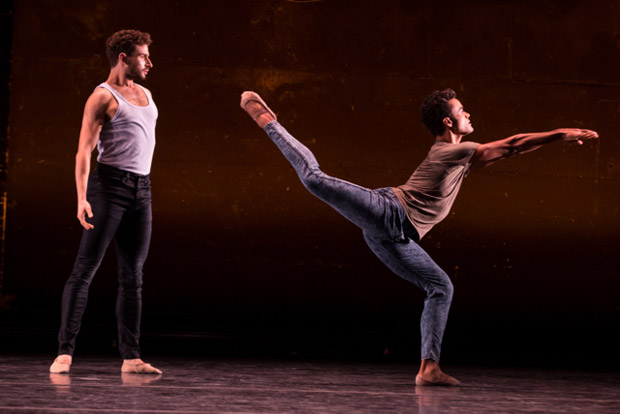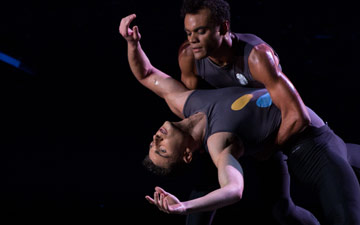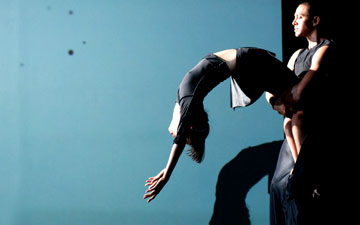
© Matthew Murphy.
BalletCollective
All That We See, Dear and Blackbirds, The Last Time This Ended, Invisible Divide
New York, Skirball Center for the Performing Arts
4 November 2015
balletcollective.com
nyuskirball.org
Emotional Intelligence
Troy Schumacher, a dancer at New York City Ballet as well as a choreographer and founder of the chamber dance company Ballet Collective, is a determined soul. Since 2011, he has been steadily honing skills as a choreographer and working to refine his approach to artistic collaboration. It hasn’t been an obvious or immediately clear path. He doesn’t have the facility of a Justin Peck; he doesn’t dazzle you with clever combinations of steps or patterns or elaborate structures. But – and this becomes clearer as his style coalesces – he has a way of harnessing the energies of the people around him: musicians, designers, and, especially, dancers. His ballets have a sense of purpose, an honesty, a directness – they’re moving. And the dancers look inspired.
Ballet Collective is performing November 4 and 5 at the Skirball Center. It’s a shame that the run is so short; these dances deserve to be seen. It is especially good to revisit two works from last year, All That We See and Dear and Blackbirds. Like all the pieces on the program, they were created through a process of give-and-take among various artists. Schumacher likes use pieces of visual art (or sometimes poetry) as a starting point. His dances are born out of conversations, exchanges of thoughts and ideas. The composers are young, working in a mode that combines chamber music, folk, rock, and an indie sensibility. In consultation with Schumacher, they create scores that reflect feelings, colors, and images drawn from the original work of art. The rest flows from there. It may sound hokey, but what this process does is provide a hidden subtext to the ballets that only the dancers know. It adds mystery and texture and emotional force.
The approach works better in some cases than others, of course. The richer and more complex the music, the better. So far, the most effective score to come out of this collaborative approach is the one for All that We See, by Ellis Ludwig-Leone. The source material was a series of details from a painting by David Salle. With blaring exclamations on the sax and wailing electric guitar riffs – played by the ensemble Hotel Elefant – the music brings out a jagged streak in the dancers, particularly the extraordinary Claire Kretzschmar. Her body seems to reach in all directions at once, expanding and contracting in less than the blink of an eye. She rides the line of a saxophone melody like a surfer on a wave. In the most exciting section of the dance, everyone responds to a different layer in the music, hopping, walking, gliding across a musical motif, tussling with a partner.
Dear and Blackbirds, also from last year, is an engrossing little duet for Ashley Laracey and Harrison Coll, inspired by a poem by Cynthia Zarin. Like much of Schumacher’s work, it has a push-and-pull quality. Laracey is delicate and elusive, Coll emotionally volatile. He circles her like a puppy; she glides past him intrigued but unwilling to yield to his ardor. The dance is full of small, telling gestures: he caresses her leg in arabesque; she plucks flowers from the air. What impresses most is Schumacher’s ability to create a convincing story between them, to build tension and a slow sizzle of sensuality. The dancers are lost in their own little world.
The Last Time This Ended, one of two new works, is a male duet inspired by images captured by the Israeli photographer Dafy Hagai. Set to a score by Mark Dancigers, this pas de deux for David Prottas and Taylor Stanley includes many elements seen in the other works: explosive jumps, splayed bodies, swimming arms, and a sense of give-and-take. But it lacks the tension and forward momentum of Dear and Blackbirds, perhaps because it’s difficult to figure out what’s at stake. The two men partner each other, imitate each other, respond to each other, but their interaction feels un-resolved.
The final piece, Invisible Divide, loosely based on a series of photographs by Paul Maffi, is perhaps the most problematic. The score, again by Ludwig-Leone, is decidedly sentimental and lacks the layering and variety that make All That We See so exciting. It consists of a moody song cycle, with a vocalist (Vanessa Upson) intoning mawkish lines like “I can’t be alone” and “I don’t want to get over you” in a breathy, child-like voice. Despite this, the dance creates a powerful image of a boy in distress. As in Dear and Blackbirds, Coll’s dancing is imbued with enormous vulnerability. He convinces us of his loneliness.
In a striking duet with Kretzschmar, he seems to pull her into a black hole of depression, yanking her around his shoulders, dropping her to the floor, folding her into his arms almost destructively. (The stark lighting, by Brandon Stirling Baker, complements the atmosphere of despair.) Then Coll erupts into an extraordinary solo filled with deep backbends, tilts, and leaps in which his body seems to explode in mid-air. Like the other dancers, Coll’s dancing is amplified by his work with Schumacher.
Schumacher’s vocabulary of movement isn’t large; there is a certain amount of repetition; and he hasn’t as yet shown an interest in the kind of big overarching structures that lend a sense of completeness to a ballet. In other words, his dances are more like portraits than landscapes. But, unlike many of the other young choreographers working in ballet today, he’s not afraid of real, messy emotion, of appearing vulnerable before the audience. It’s choreography at the service of expression. Schumacher is not only determined, but also brave.

















You must be logged in to post a comment.